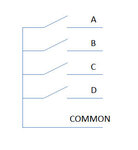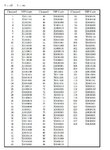tait 700
Junior Member level 2
Hi,
Was wondering if someone could tell me if the following was possible using a PIC as the main component ?
I have a Radio receiver that uses 7 input lines to select its various preprogrammed channels in its main Eprom. These lines are switched either Logic High or logic low in various combinations, eg. Channel 4 has 5 lines at Low and 2 lines at High Level, Channel 8 has 6 lines at low and 1 at High.
There are 15 different combinations of the 7 lines either High or low ( 15 Channels ). The system uses Dip switches that ground each line to manually select the correct channel in a preselect operation, and uses the changing logic states of the lines when the External channel selector is being used.
My ideal solution would be if i could have one momentary switch that when operated caused the PIC to go up one channel at a time switching each of the 7 lines either high or low as instructed by its program. Either that or a two way momentary switch that could go up the channel list or down the channel list depending on which way the switch was operated.
The lines have to remain stationary once selected and the PIC is taking the place of the Dip switches sending each line either high or low.
If it was possible to have some form of indication, either a LCD or Twin 7 Seg LED that displayed what was selected by the PIC, would be a big help.
Any info on the above would be most appreciated, i have little knowledge of this topic but it seems to be the easiest way to achieve a solution to this problem if it is possible.
Regards,
Chris S.
Was wondering if someone could tell me if the following was possible using a PIC as the main component ?
I have a Radio receiver that uses 7 input lines to select its various preprogrammed channels in its main Eprom. These lines are switched either Logic High or logic low in various combinations, eg. Channel 4 has 5 lines at Low and 2 lines at High Level, Channel 8 has 6 lines at low and 1 at High.
There are 15 different combinations of the 7 lines either High or low ( 15 Channels ). The system uses Dip switches that ground each line to manually select the correct channel in a preselect operation, and uses the changing logic states of the lines when the External channel selector is being used.
My ideal solution would be if i could have one momentary switch that when operated caused the PIC to go up one channel at a time switching each of the 7 lines either high or low as instructed by its program. Either that or a two way momentary switch that could go up the channel list or down the channel list depending on which way the switch was operated.
The lines have to remain stationary once selected and the PIC is taking the place of the Dip switches sending each line either high or low.
If it was possible to have some form of indication, either a LCD or Twin 7 Seg LED that displayed what was selected by the PIC, would be a big help.
Any info on the above would be most appreciated, i have little knowledge of this topic but it seems to be the easiest way to achieve a solution to this problem if it is possible.
Regards,
Chris S.


